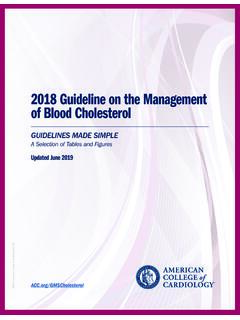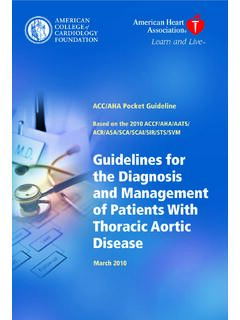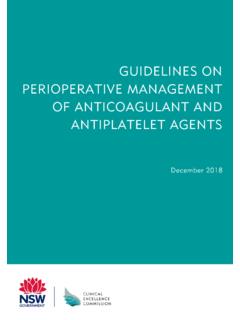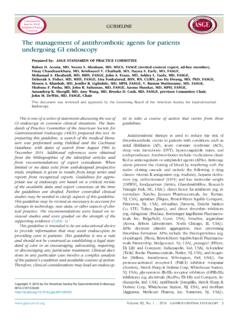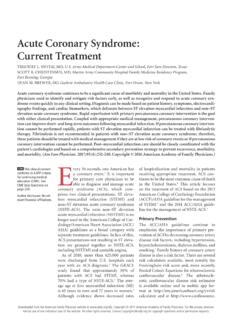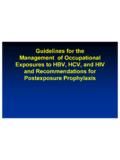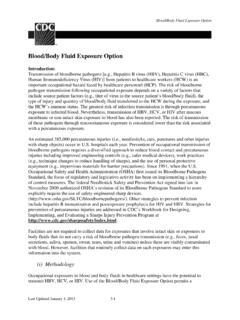Transcription of 2019 AHA/ACC/HRS Focused Update of the 2014 Guideline …
1 2019 AHA/ACC/HRS Focused Update of the 2014 Guideline for management of patients with atrial FibrillationGUIDELINES MADE SIMPLE - Focused Update EditionA Selection of Tables and Figures 2018, American College of Cardiology AHA/ACC/HRS Focused Update of the 2014 Guideline for management of patients with atrial FibrillationA report of the American College of Cardiology/American Heart Association Task Force on Clinical Practice Guidelines, and the Heart Rhythm SocietyCraig T. January, MD, PhD, FACC, ChairL. Samuel Wann, MD, MACC, FAHA, Vice Chair Hugh Calkins, MD, FACC, FAHA, FHRSLin Y. Chen, MD, MS, FACC, FAHA, FHRSJ oaquin E. Cigarroa, MD, FACCJ oseph C.
2 Cleveland, Jr, MD, FACCP atrick T. Ellinor, MD, PhDMichael Exekowitz, MBChB, DPhil, FACC, FAHAM ichael E. field, MD, FACC, FAHA, FHRSK aren Furie, MD, MPH, FAHAPaul Heidenreich, MD, FACC, FAHAK atherine T. Murray, MD, FACC, FAHA, FHRSJ ulie B. Shea, MS, RNCS, FHRSC ynthia M. Tracy, MDClyde W. Yancy, MD, MACC, FAHACITATION: Committee:The purpose of the 2019 Focused Update is to Update the 2014 AHA/ACC/HRS Guideline for the management of patients with atrial fibrillation in areas where new evidence has emerged since its publication. The scope of this Update of the 2014 AF Guideline includes revisions to the section on anticoagulation due to the approval of new medications and thromboembolism protection devices, the section on catheter ablation of AF, revisions to the section on the management of AF complicating acute coronary syndrome, and new sections on device detection of AF and weight loss.
3 The following resource contains recommendation tables from the 2019 AF Focused Update as well as a comparison tool that highlights the major new and modified recommendations in the 2019 Focused Update . The resource is only an excerpt from the document and the full publication should be reviewed for important Focused Update : 2014-2019 Comparison Tool ..4-5 Selecting an Anticoagulant Regimen Balancing Risks and Benefits ..6-8 Interruption and Bridging Anticoagulation ..9 percutaneous Approaches to Occlude the LAA .. 10 Cardiac Surgery LAA Occlusion/Excision .. 10 Prevention of Thromboembolism .. 11 Ablation in HF .. 12AF Complicating ACS.
4 13 Device Detection of AF and atrial Flutter .. 14 Weight Reduction in patients with AF .. 14 Selected Table or Figure Page2019 AHA/ACC/HRS Focused Update of the 2014 Guideline for management of patients with atrial FibrillationGUIDELINES MADE SIMPLE 2019 AHA/ACC/HRS Focused Update of the 2014 Guideline for management of patients with atrial FibrillationAF4 Back to Table of ContentsSection - Selection of Antithrombotic RegimenSection - Prevention of ThromboembolismIIIaIIbIIIOral anticoagulants recommended for high risk patients now include criteria for CHA2DS2-VASc assessment and use of NOACs now defined as moderate tosevere mitral stenosis or a mechanical heart patients with AF and end-stage chronic kidney disease.
5 The direct thrombin inhibitor dabigatran,or the factor Xa inhibitors rivaroxaban OR edoxaban are not recommended. 2014 2019 The term nonvalvular AF is no longer usedFor patients with AF or atrial flutter of <48 hours'duration with a CHA2DS2-VASc score of 2 in menand 3 in women, administration of heparin, afactor Xa inhibitor, or a direct thrombin inhibitor isreasonable as soon as possible before cardioversion,followed by long term anticoagulation patients with AF or atrial flutter of 48 hours duration or longer, or when the duration of AF isunknown, anticoagulation with warfarin (INR ), a factor Xa inhibitor, or direct thrombininhibitor is recommended for at least 3 weeksbefore and at least 4 weeks after in Guideline Recommendations (Only major included)Upgraded to Class IRecommendationDowngraded to Class Comparison Tool (1 of 2)
6 Table will continue in the next MADE SIMPLE 2019 AHA/ACC/HRS Focused Update of the 2014 Guideline for management of patients with atrial FibrillationAF5 Back to Table of ContentsSection - Selection of Antithrombotic RegimenSection - Interruption and Bridging AnticoagulationSection - percutaneous Approaches to Occlude the Left atrial AppendageSection - Catheter Ablation in HFSection - Complicating Acute Coronary SyndromeSection - Device Detection of AF and atrial FlutterSection - Weight Loss NOACs are recommended over warfarin where eligible except in those patients with moderate - severemitral stenosis or a mechanical heart is the reversal agent for dabigatran in the event of life-threatening bleeding or an urgent LAAO should be considered for those AF patients at an increased risk of stroke who havecontraindications to long-term anticoagulation and who are at high risk of thromboembolic ablation of AF is reasonable in symptomatic AF patients with HF and reduced triple therapy is prescribed post-stent placement, clopidogrel is preferred over therapy with a P2Y12 inhibitor and dose adjusted vitamin K antagonist is reasonable therapy with clopidogrel and low-dose rivaroxaban (15 mg daily)
7 May be reasonable therapy with a P2Y12 inhibitor and dabigatran 150 mg twice daily is reasonable triple therapy is prescribed for patients with AF who are at increased risk of stroke and who haveundergone PCI with stenting for ACS, a transition to double therapy at 4-6 weeks may be patients with cardiac implantable electronic devices, atrial high rate episodes (AHREs) should promptfurther loss and risk factor modification is recommended for overweight/obese patients with patients with cryptogenic stroke in whom long-term external ambulatory monitoring isinconclusive implantation of a cardiac monitor is reasonable to detect silent Alfa is the reversal agent for apixaban and Comparison Tool (2 of 2)GUIDELINES MADE SIMPLE 2019 AHA/ACC/HRS Focused Update of the 2014 Guideline for management of patients with atrial FibrillationAF6 Back to Table of ContentsRecommendations for Selecting an Anticoagulant Regimen Balancing Risks and Benefits (1 of 3)
8 Table will continue in the next for Selecting an Anticoagulant Regimen Balancing Risks and Benefits COR LOE Recommendations I A 1. For patients with AF and an elevated CHA2DS2-VASc score of 2 or greater in men or 3 or greater in women, oral anticoagulants are recommended. Options include: Warfarin (LOE: A) Dabigatran (LOE: B) Rivaroxaban (LOE: B) Apixaban (LOE: B) or Edoxaban (LOE: B-R) MODIFIED: This recommendation has been updated in response to the approval of edoxaban, a new factor Xa inhibitor. More precision in the use of CHA2DS2-VASc scores is specified in subsequent recommendations. The LOEs for warfarin, dabigatran, rivaroxaban, and apixaban have not been updated for greater granularity as per the new LOE system.
9 (Section in the 2014 AF Guideline ) The original text can be found in Section of the 2014 AF Guideline . Additional information about the comparative effectiveness and bleeding risk of NOACs can be found in Section B B B B-R I A 2. NOACs (dabigatran, rivaroxaban, apixaban, and edoxaban) are recommended over warfarin in NOAC-eligible patients with AF (except with moderate-to -severe mitral stenosis or a mechanical heart valve). NEW: Exclusion criteria are now defined as moderate-to-severe mitral stenosis or a mechanical heart valve. When the NOAC trials are considered as a group, the direct thrombin inhibitor and factor Xa inhibitors were at least noninferior and, in some trials, superior to warfarin for preventing stroke and systemic embolism and were associated with lower risks of serious bleeding.
10 I A 3. Among patients treated with warfarin, the international normalized ratio (INR) should be determined at least weekly during initiation of anticoagulant therapy and at least monthly when anticoagulation (INR in range) is stable. MODIFIED: Antithrombotic was changed to anticoagulant. I B 4. In patients with AF (except with moderate-to -severe mitral stenosis or a mechanical heart valve), the CHA2DS2-VASc score is recommended for assessment of stroke risk. MODIFIED: Exclusion criteria are now defined as moderate-to-severe mitral stenosis or a mechanical heart valve. patients with AF with bioprosthetic heart valves are addressed in the supportive text.


